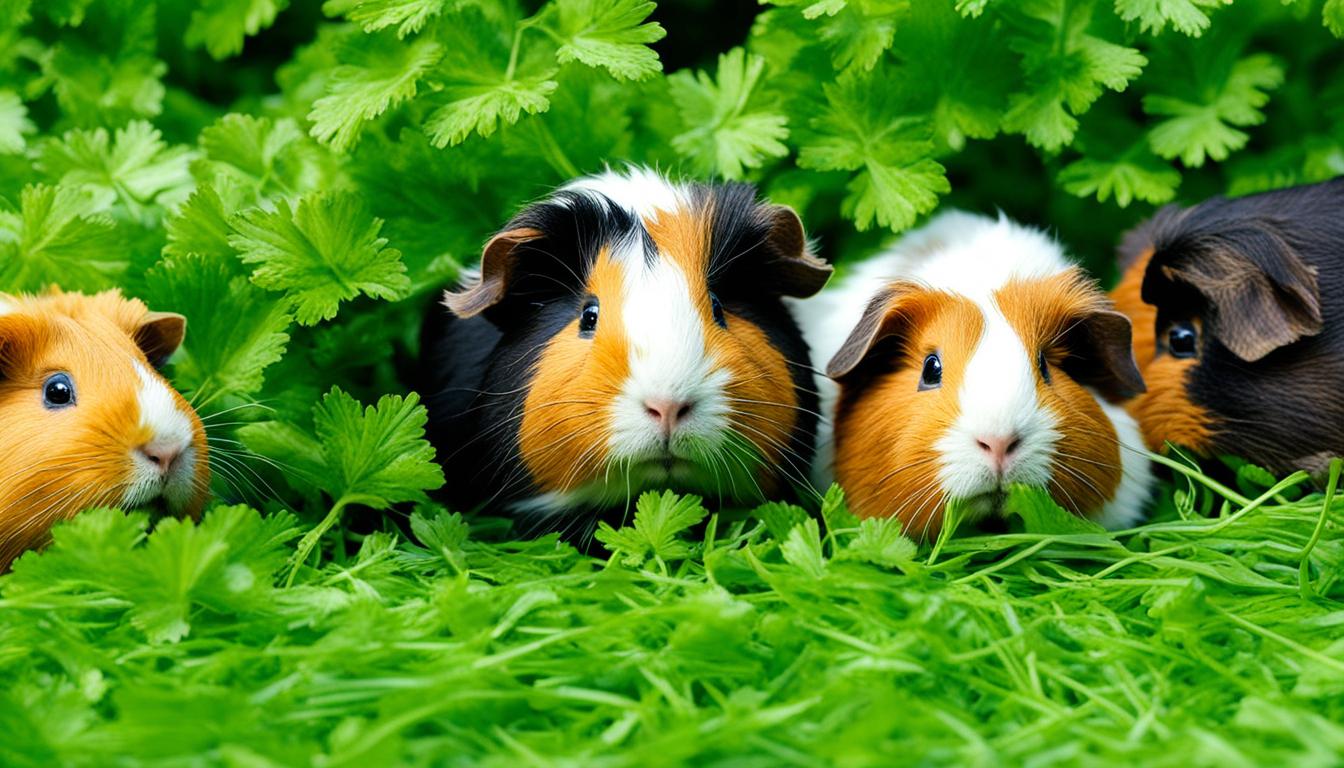Have you ever wondered if guinea pigs can eat parsley? Well, you’re in the right place! As responsible pet owners, we always want to ensure that our furry friends have a healthy and balanced diet. In this article, we will explore the benefits of including parsley in your guinea pig’s diet and how to do it safely.
Guinea pigs can indeed eat parsley, and it is actually packed with essential nutrients that are beneficial for their well-being. Parsley is renowned for its high vitamin C content, even surpassing the levels found in many fruits and vegetables. Additionally, it is rich in calcium, which is necessary for the development of strong bones and teeth in guinea pigs. However, it’s important to note that moderation is key to prevent the formation of bladder stones.
Key Takeaways:
- Parsley is safe for guinea pigs to eat and provides essential nutrients.
- It is high in vitamin C, which is crucial for their overall health.
- Moderation is important to prevent bladder stones due to the calcium content.
- Include parsley as part of a varied diet that includes other fresh foods.
- Choose organic parsley to avoid chemicals or pesticides.
The Nutrition Value of Parsley for Guinea Pigs
When it comes to the diet of guinea pigs, parsley is a nutritious addition that can provide several health benefits. This herb is packed with essential nutrients, making it a valuable food choice for your furry friend.
Parsley is rich in vitamin C, which plays a crucial role in guinea pigs’ overall health and well-being. This vitamin helps boost their immune system, promotes healthy skin, and aids in proper wound healing. Guinea pigs cannot produce vitamin C on their own, so it is vital to provide them with a dietary source, and parsley is an excellent option.
Furthermore, parsley is also high in calcium, which contributes to the development and maintenance of strong bones and teeth in guinea pigs. However, it is important to note that while calcium is essential, excessive levels can lead to bladder stones. Therefore, it’s crucial to offer parsley in moderation and ensure a balanced diet that includes other fresh foods.
The Nutrition Value of Parsley for Guinea Pigs
| Nutrient | Amount per 100g |
|---|---|
| Vitamin C | 133mg |
| Calcium | 138mg |
| Fiber | 2.2g |
| Sugar | 0.9g |
Parsley offers additional benefits as well. It is low in sugar and high in fiber, making it a healthy choice for guinea pigs. The fiber content aids in proper digestion and helps prevent gastrointestinal issues. Plus, the low sugar content helps maintain stable blood sugar levels, preventing potential health complications.
When incorporating parsley into your guinea pig’s diet, remember to introduce it gradually and observe their reaction. Start with smaller amounts and gradually increase the serving size. This allows their digestive system to adjust and minimizes the risk of any adverse effects.
In conclusion, parsley is a nutritious herb that can contribute to your guinea pig’s overall well-being. Its high vitamin C and calcium content make it a valuable addition to their diet. However, remember to offer it in moderation and alongside a varied selection of fresh foods to ensure a well-balanced and healthy diet for your furry friend.
How to Incorporate Parsley into Your Guinea Pig’s Diet
Feeding parsley to your guinea pig is a great way to add variety to their diet and provide them with essential nutrients. Here are some tips on how to incorporate parsley into your guinea pig’s meals:
- Offer parsley in moderation: While parsley is nutritious, it should be fed in moderation to prevent any potential health issues. Aim to feed parsley to your guinea pig once or twice a week, allowing a few days in between each feeding.
- Include it in a varied diet: Alongside parsley, make sure to provide a diverse range of fresh foods to your guinea pig. This can include other leafy greens, vegetables, and fruits that are safe for guinea pigs. By offering a variety of foods, you ensure that your guinea pig gets all the necessary nutrients.
- Prepare and serve parsley correctly: Wash the parsley thoroughly to remove any dirt or chemicals. You can then offer the whole plant, including the stalks, to your guinea pig. However, make sure to remove any wilted or discolored parts before serving.
By following these guidelines, you can easily incorporate parsley into your guinea pig’s diet and provide them with a nutritious and balanced meal. Remember, always consult with a veterinarian before making any significant changes to your guinea pig’s diet.

The Benefits of Fresh Herbs for Guinea Pigs
Parsley is just one of the many fresh herbs that can benefit your guinea pig’s health. Adding fresh herbs to their diet not only enhances the flavor but also provides additional nutrients. Here are some other herbs that you can consider offering to your guinea pig:
- Basil: Rich in antioxidants, basil can support the immune system and provide anti-inflammatory properties.
- Mint: Known for its soothing effects on the digestive system, mint can help alleviate any stomach discomfort your guinea pig may experience.
- Cilantro: A good source of vitamin C and antioxidants, cilantro can promote overall health and well-being in guinea pigs.
Remember to introduce new herbs gradually into your guinea pig’s diet and monitor their response. Always choose fresh, organic options whenever possible to avoid any potential harmful chemicals. Your guinea pig will appreciate the variety and added nutritional benefits that fresh herbs can provide.
Other Healthy Herbs and Greens for Guinea Pigs
While parsley is a great addition to a guinea pig’s diet, there are other herbs and greens that can provide additional health benefits. These safe herbs not only add variety to their meals but also offer nutritional value. Here are some other herbs and greens that guinea pigs can enjoy:
Bell Peppers
Bell peppers are a fantastic source of vitamin C for guinea pigs. They contain even more vitamin C than oranges! These colorful veggies are low in calcium, making them a perfect choice for your furry friend. Just make sure to remove the seeds and stems before feeding bell peppers to your guinea pig.
Spring Greens
Spring greens, such as spinach and kale, are another excellent option for guinea pigs. They are rich in vitamin C and provide a good amount of fiber. However, due to their high calcium content, it’s crucial to feed spring greens in moderation. A small handful once or twice a week is sufficient to keep your guinea pig healthy.
Carrots, Basil, and Coriander
Carrots are a popular treat for guinea pigs and can be given in small amounts. They are a good source of vitamin A and provide a crunchy texture that guinea pigs enjoy. Basil and coriander are aromatic herbs that can be added to their diet for some extra flavor. Remember to introduce new foods gradually to avoid digestive issues.
It’s important to note that these herbs and greens should not replace the staple components of a guinea pig’s diet, such as hay and pellets. They should be offered as occasional treats and supplements to ensure a well-rounded nutritional intake.

Table: Comparison of Nutritional Content
| Fresh Herb/Green | Vitamin C (mg/100g) | Calcium (mg/100g) | Fiber (g/100g) |
|---|---|---|---|
| Bell Peppers | 128 | 10 | 2.1 |
| Spring Greens | 18 | 183 | 2.6 |
| Carrots | 5.9 | 33 | 2.8 |
| Basil | 18 | 177 | 1.6 |
| Coriander | 27 | 67 | 2.8 |
Precautions When Feeding Parsley to Guinea Pigs
When it comes to feeding parsley to your guinea pigs, it’s important to take some precautions to ensure their health and well-being. While parsley is generally safe for guinea pigs to consume, excessive consumption can lead to bladder stones due to its high calcium content. Therefore, it is crucial to feed parsley in moderation and not make it the sole source of food for your furry friends.
To avoid any potential health issues, it is recommended to provide a varied diet for your guinea pigs, including parsley along with other fresh foods. This will help ensure they receive a balanced intake of nutrients and prevent any imbalances that can arise from relying solely on one type of food. Offering a diverse range of vegetables, fruits, and other herbs alongside parsley will provide your guinea pigs with a well-rounded diet.
When feeding parsley to your guinea pigs, it is also essential to choose organic options whenever possible. Chemicals and pesticides used on conventionally grown parsley can be harmful to your guinea pigs’ health. Opting for organic parsley will minimize their exposure to harmful substances and promote their overall well-being.

Table: Comparison of Common Herbs for Guinea Pigs
| Herb | Vitamin C content | Calcium content | Feeding Frequency |
|---|---|---|---|
| Parsley | High | High | Once or twice a week |
| Basil | Low | Low | A few times a week |
| Cilantro | Low | Low | A few times a week |
| Mint | Low | Low | A few times a week |
By following these precautions and incorporating parsley into a balanced diet, you can provide your guinea pigs with the necessary nutrients while minimizing the risk of any health issues. Remember to consult your veterinarian for specific dietary recommendations and always monitor your guinea pigs’ overall health and behavior. With a thoughtful approach to their diet, you can ensure your guinea pigs lead a happy and healthy life.
Conclusion
Guinea pig nutrition is key to ensuring our furry friends stay healthy and happy. Including parsley in their diet can provide essential nutrients such as vitamin C and calcium. However, moderation is crucial in order to prevent any potential health issues.
We recommend offering parsley as part of a varied selection of fresh foods. This will help guinea pigs meet their nutritional needs while avoiding overconsumption of any one ingredient. Remember, a diverse diet is the cornerstone of their well-being.
While parsley can be a tasty treat for guinea pigs, it should not be the sole source of food. It is important to provide a balanced diet that includes a variety of vegetables, herbs, and grasses suitable for guinea pigs.
By prioritizing guinea pig nutrition and incorporating parsley alongside other fresh foods, we can ensure that our beloved pets receive the nutrients they need to thrive. So, go ahead and offer parsley to your guinea pig as an occasional treat, knowing that you are providing them with a nutritious addition to their diet.
FAQ
Can guinea pigs eat parsley?
Yes, guinea pigs can eat parsley. It is a nutritious food packed with essential nutrients for their diet.
What nutrients does parsley provide for guinea pigs?
Parsley is rich in vitamin C, which is necessary for guinea pigs’ overall health. It also contains high levels of calcium, important for their bones and teeth development.
How often should I feed parsley to my guinea pigs?
It is recommended to feed parsley once or twice a week, with a few days’ gap between each feeding. About 5-10 sprigs of parsley can be given at a time.
Can guinea pigs eat the stalks of parsley?
Yes, the whole plant, including the stalks, can be fed to minimize waste.
What other herbs and greens are good for guinea pigs?
Other beneficial options include bell peppers, spring greens, carrots, basil, and coriander.
Are there any precautions when feeding parsley to guinea pigs?
Yes, excessive consumption of parsley can lead to bladder stones due to its high calcium content. It should be fed in moderation and not be the sole source of food.
Can I feed parsley treated with chemicals or pesticides to my guinea pigs?
It is best to avoid feeding parsley treated with chemicals or pesticides. Opt for organic options when possible.




